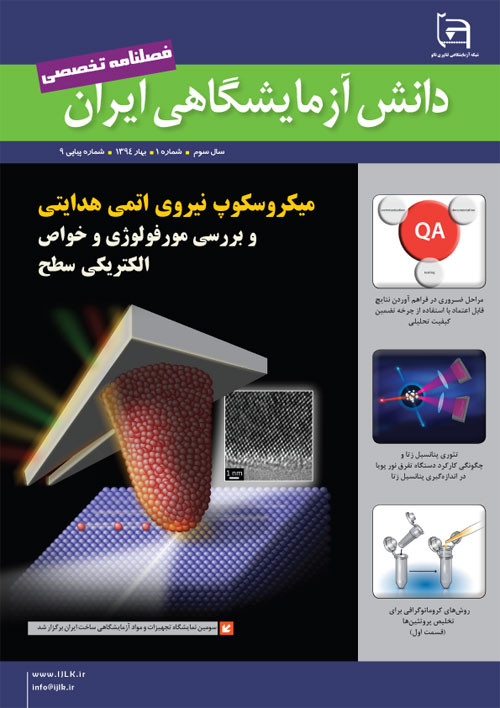فهرست مطالب

مجله دانش آزمایشگاهی ایران
سال سوم شماره 1 (پیاپی 9، بهار 1394)
- تاریخ انتشار: 1394/03/20
- تعداد عناوین: 7
- اخبار
- استاندارد
- مقالات
-
صفحه 39
-
Page 5
Photoconductive AFM has been well-known as a effective and applicable method to investigate morphology in nanoscale and surface properties simultaneously. It, also, images the relationship between function-properties and structure in nanoscale materials. Similar to other methods of AFM, this technic possess specific machinery including a reversed microscope and a light source. In this regards, PC-AFM can be used to characterization of hole-electron transfer in photoconductive cells and organic solar cells. In fact, PC-AFM is still novel and requires to be investigated and developed.
Keywords: photoconductive AFM, photovolatieccells, organic solar cells, reversedmicroscope -
Page 14
The zeta potential is the overall charge a particle acquires in a specific medium. The measurement of zeta potential is an important factor in the stability of colloidal materials. It plays an important role in theory of aggregative stability. There are a few ways to measure the zeta potential. This paper explained theory of zeta potential and how it is measured by DLS.
Keywords: Zeta potential, DLS, dynamic light scattering, stability of the solution -
Page 21
To achieve a high level of purity in the purification of proteins for therapeutic or analytical application, it is necessary to use several chromatographic steps. There is a range of techniques available including anion and cation exchange, which can be carried out at different pHs, hydrophobic interaction chromatography, size exclusion and affinity chromatography. Separation by HPLC can be done by reverse-phase, ion-exchange or size-exclusion methods. Reverse-phase chromatography (RPC) separates proteins based on their relative hydrophobicities. This technique is highly selective but requires the use of organic solvents. Some proteins are permanently denatured by solvents and will lose functionality during RPC, therefore this method is not recommended for all applications. Ion-exchange chromatography refers to separation of proteins based on charge. Size-exclusion chromatography (gel filtration) separates larger proteins from small ones. Affinity chromatography is a very useful technique for "polishing" or completing the protein purification process. Beads in the chromatography column are cross-linked to ligands that bind specifically to the target protein.
Keywords: High Performance Liquid Chromatography, Protein, Ion Exchange Chromatography, Hydrophobic Interaction Chromatography -
Page 27
Considering how demand for quality assurance (QA) has grown in analytical laboratories, we show the trends in analytical science, illustrated through international standard ISO/IEC 17025, validation, measurements of uncertainty, and quality-control (QC) measures. A detailed review of the history of analytical chemistry indicates that these concepts are consistently used in laboratories to demonstrate their traceabilities and competences to provide reliable results. We propose a new approach for laboratory QA, which also develops a diagram to support routine laboratories (which generally apply a quality system, such as ISO/ IEC 17025) or research laboratories (that have some difficult applying this international standard). This approach, called the Analytical Quality Assurance Cycle (AQAC), presents the major QA concepts and the relationships between these concepts in order to provide traceability and reliable results. The AQAC is a practical tool to support the trend towards QA in analytical laboratories.
Keywords: Analytical Quality AssuranceCycle (AQAC), Analytical laboratory, ISO, IEC 17025, Laboratoryquality assurance, Quality assurance(QA), Quality control (QC), Reliableresult, Traceability, Uncertainty, Validation


